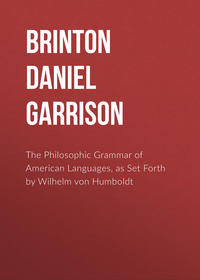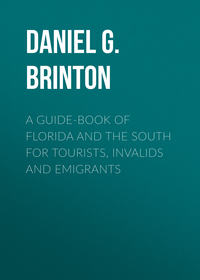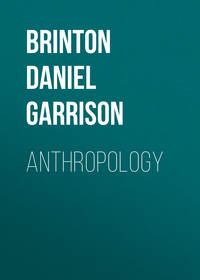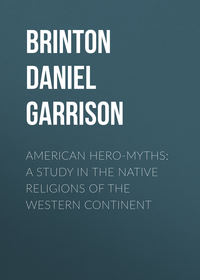 полная версия
полная версияThe American Race
The religious sentiment was awake in all the tribes of the continent, and even the lowest had myths and propitiatory rites by which to explain to themselves and cajole to their own interests the unknown powers which order the destiny of human life. There is a singular similarity in these myths. The leading cycle of them usually describes the exploits of a divine man, the national hero-god, who was the first instructor, often the ancestor of the tribe, and the creator of the visible universe. His later history is related with singular parallelism by tribes in Canada and Mexico, in Yucatan and Uruguay. After teaching his people the arts of life and the sacred rites, the forms of their social organizations and the medicinal powers of plants, he left in some mysterious way, not by the event of death, but for a journey, or by rising to the sky; leaving with them, however, his promise to return at some future day, when they should need him, and he should again become their guide and protector.
The interpretation of this fundamental American myth, which I have shown to be the typical religious legend of the race,60 offers an interesting problem. Comparing it with others of similar form in Egyptian and Aryac antiquity, I have explained it as based on the natural phenomenon of the returning and departing day, as, if not a solar, at least a light myth, developed through personification and etymologic processes. Often the hero-god is identified with some animal, as the raven, the rabbit, the wolf or coyote, the jaguar, the toucan, etc. Possibly in these we may recognize the “totemic animal” after which the gens was named; but in most cases the identification cannot be made.
The hero-god is usually connected with tales of a creation and a flood, or other destruction of the world. These cosmogonical and cataclysmal myths belong together, and arise from the same impulse to explain cosmic phenomena by the analogy with ordinary changes of the seasons and the day. In constant connection with them, and also with the rites of religion and medicine, with the social institutions and the calendar, with the plans of edifices and the arrangement of gens and phratries, in fact, with all the apparatus of life, was a respect for the sacred number. It is strange how constantly this presents itself throughout American life, and is, in fact, the key to many of its forms. The sacred number is Four, and its origin is from the four cardinal points. These were the guides to the native in his wanderings, and, as identified with the winds, were the deities who brought about the change of the seasons and the phenomena of the weather. They were represented by the symbols of the cross, whose four arms we see portrayed on the altar tablet of Palenque, on the robes of the Mexican priests, in the hieroglyphs of the Algonkins, and in countless other connections.
A rich symbolism rapidly developed in all the sedentary tribes, and very much along the same lines. The bird, the serpent, the sacred stone, the tree of life, water as a purifier, the perpetual fire, all these are members of a religious symbolism, clear signs of which recur in all segments of the continent. The chants and dances, the ritual of the medicine men, the functions of esoteric orders and secret societies, present a resemblance greater than that which can be explained by a mere similarity in the stage of culture. I explain it by the ethnic and psychical unity of the race, and its perpetual freedom from any foreign influence.
The mortuary rites indicated a belief in the continued existence of the individual after apparent death. These were by incineration, by inhumation, by exposure, or by mummification. Articles were placed with the deceased for use in his future state, and the ceremonies of mourning were frequently severe and protracted. A sacredness was generally attached to the bones and therefore these were carefully preserved. In accordance with a superstition widely felt in the Old World, they were supposed to harbor some share of the departed spirit. The conception of the after life is wholly material. The Zapotec, for instance, believes that he will return to his familiar haunts after a few hundred years, and buries all the money he makes that he may then live at his ease. Von Gagern estimates the amount of silver thus secreted and lost within the last century at a hundred million dollars.61
The ceremonies of religion, which included that of the treatment of disease, inasmuch as a demonic cause was always assigned to illness, were in the hands of a particular class, known to the whites as “medicine men,” or shamans, or sorcerers. Sometimes the right of belonging to this order was hereditary in a gens, but generally peculiar aptitude for the business was the only requirement. Many of them were skilled in legerdemain, and even to-day some of their tricks puzzle the acutest white observers. As doctors, augurs, rain-makers, spell-binders, leaders of secret societies, and depositaries of the tribal traditions and wisdom, their influence was generally powerful. Of course it was adverse to the Europeans, especially the missionaries, and also of course it was generally directed to their own interest or that of their class; but this is equally true of priestly power wherever it gains the ascendency, and the injurious effect of the Indian shamans on their nations was not greater than has been in many instances that of the Christian priesthood on European communities.
The psychic identity of the Americans is well illustrated in their languages. There are indeed indefinite discrepancies in their lexicography and in their surface morphology; but in their logical substructure, in what Wilhelm von Humboldt called the “inner form,” they are strikingly alike. The points in which this is especially apparent are in the development of pronominal forms, in the abundance of generic particles, in the overweening preference for concepts of action (verbs), rather than concepts of existence (nouns), and in the consequent subordination of the latter to the former in the proposition. This last mentioned trait is the source of that characteristic which is called incorporation. The American languages as a rule are essentially incorporative languages, that is, they formally include both subject and object in the transitive concept, and its oral expression. It has been denied by some able linguists that this is a characteristic trait of American languages; but I have yet to find one, of which we possess ample means of analysis, in which it does not appear in one or another of its forms, thus revealing the same linguistic impulse. Those who reject it as a feature have been led astray either by insufficient means of information about certain languages, or by not clearly comprehending the characteristics of the incorporative process itself.62
As intimated, however, in spite of this underlying sameness, there is wide diversity in the tongues themselves. Where we cannot find sufficient coincidences of words and grammar in two languages to admit of supposing that under the laws of linguistic science they are related, they are classed as independent stocks or families. Of such there are about eighty in North and as many in South America. These stocks offer us, without doubt, our best basis for the ethnic classification of the American tribes; the only basis, indeed, which is of any value. The efforts which have been heretofore made to erect a geographic classification, with reference to certain areas, political or physical; or a craniological one, with reference to skull forms; or a cultural one, with reference to stages of savagery and civilization, have all proved worthless. The linguistic is the only basis on which the subdivision of the race should proceed. Similarity of idioms proves to some extent similarity of descent and similarity of psychic endowments. Of course, there has been large imposition of one language on another in the world’s history; but never without a corresponding infiltration of blood; so that the changes in language remain as evidence of national and race comminglings. I select, therefore, the linguistic classification of the American race as the only one of any scientific value, and, therefore, that which alone merits consideration.
The precise number of linguistic stocks in use in America at the discovery has not been made out. In that portion of the continent north of Mexico the researches of the Bureau of Ethnology of the United States have defined fifty-nine stocks, no less than forty of which were confined to the narrow strip of land between the Rocky mountains and the Pacific ocean.
For convenience of study I shall classify all the stocks into five groups, as follows:—
I. The North Atlantic Group.
II. The North Pacific Group.
III. The Central Group.
IV. The South Pacific Group.
V. The South Atlantic Group.
This arrangement is not one of convenience only; I attach a certain ethnographic importance to this classification. There is a distinct resemblance between the two Atlantic groups, and an equally distinct contrast between them and the Pacific groups, extending to temperament, culture and physical traits. Each of the groups has mingled extensively within its own limits, and but slightly outside of them. Each is subject to conditions of temperature, altitude and humidity, which are peculiar to itself, and which have exerted definite influences on the constitution and the history of its inhabitants. Such a subdivision of the race is therefore justified by anthropologic considerations.
NORTH AMERICAN TRIBES
I. THE NORTH ATLANTIC GROUP
1. THE ESKIMOS
The word Eskimo, properly Eski-mwhan, means in the Abnaki dialect of Algonquin, “he eats raw flesh,” and was applied to the tribe from its custom of consuming fish and game without cooking. They call themselves Innuit, “people,” a term the equivalent of which is the usual expression applied by American natives to their own particular stock.
The Innuit are at present essentially a maritime and arctic nation, occupying the coast and adjacent islands from the Straits of Belle Isle on the Atlantic to Icy Bay, at the foot of Mount St. Elias on the Pacific, and extending their wanderings and settlements as far up Smith’s Sound as N. Lat. 80°, where they are by far the northernmost inhabitants of the earth. They have occupied Greenland for certainly more than a thousand years, and were the earliest settlers in some of the Aleutian islands. Portions of them at some remote period crossed Behring Strait and settled on Asiatic soil, while others established themselves along the shores of Newfoundland. Indeed, from the reports of the early Norse explorers and from the character of relics found on the Atlantic coast, it is probable that they once extended as far south as the mouth of the Delaware river.63 Their ancestors quite possibly dwelt on the moors of New England when the reindeer browsed there, and accompanied that quadruped in his final migration to the north. They belong in history and character to the Atlantic peoples.
This question, as to where their common progenitors resided, has been much discussed. A favorite theory of some writers has been that they migrated out of Asia by way of Behring Strait; but those who have studied their culture on the spot do not advocate this opinion. These observers have, without exception, reached the conclusion that the Innuit were originally an inland people, that their migrations were toward the north and west, and that they have been gradually forced to the inhospitable climes they occupy by the pressure of foes. Dr. Rink, who passed many years among them, would look for their early home somewhere in Alaska; but Mr. John Murdoch and Dr. Franz Boas, two of our best authorities on this tribe, incline to the view that their primal home was to the south of Hudson Bay, whence they separated into three principal hordes, the one passing into Labrador and reaching Greenland, the second moving to the coast of the Arctic sea, and the third to Alaska. These form respectively the Greenland, the Chiglit and the Kadjak dialects of the common tongue.64
The closest observers report the physical traits of the Eskimos as thoroughly American and not Asian, as has sometimes been alleged.65 In appearance the Innuits of pure blood are of medium or slightly undersize, color dark, nose prominent and sometimes aquiline, hair dark brown or black, moderately strong on the face, the pubes and in the axilla; the eyes are dark brown and occasionally blue. The skull is generally long (dolichocephalic), but is subject to extensive variations ranging from almost globular to exceptionally long and narrow specimens.66
In spite of the hardships of their life, the Innuits are of a singularly placid and cheerful temperament, good-natured among themselves and much given to mirth and laughter.67 The ingenuity with which they have learned to overcome the difficulties of their situation is quite surprising. In a country without wood or water, frightfully cold, and yielding no manner of edible fruit or vegetable, they manage to live and thrive. Their principal nurriture is the product of the sea. They build boats called kayaks or bidarkas from the bones of walrus covered with the skins of seals; their winter houses are of blocks of snow laid up on the principle of the circular arch to form a dome, with windows of sheets of ice. These they warm by means of stone lamps fed with blubber oil. Their clothing is of bird skins and furs, and they are skilled in the preparation of a sort of leather. As faithful companions they have their dogs, intelligent animals, used both in hunting and for drawing small sledges built of wood or bone.
With their tools of bone or stone they fashion many curious and useful articles, displaying a marked inventive faculty and an artistic eye. The picture-writing which they devised for the assistance of their memory is greatly superior to any found north of Mexico in the faithful delineation of objects, especially of animal forms.68
The long winter nights are enlivened by music and songs, of which they are passionately fond, and by the recital of imaginative tales, the stock of which is inexhaustible. A skillful bard enjoys a wide reputation, and some of their poems contain fine and delicate sentiments.69 Others are from ancient date, and are passed down from generation to generation with scrupulous fidelity, every tone, every gesture, being imitated. The meter and rendition of their songs seem to the European monotonous, but the Eskimo has his own notion of the music of verse, and it is a very advanced one; he would have it akin to the sweet sounds of nature, and for that reason their poets sleep by the sound of running water that they may catch its mysterious notes, and model on them their own productions.70 These songs also serve as a peaceful means to allay feuds. When two persons quarrel, they will appoint an evening and sing “nith songs” at each other, and the audience will decide which comes out best. This verdict will put an end to the ill-feeling.
The imaginative character of the people is also reflected in their religions. They believe in one or several overruling powers, and in a multitude of inferior spirits and uncanny monsters. These require propitiation rather than worship. The general belief is that a person has two souls, one of which is inseparably connected with his name and passes with it to any infant named for him; while the second either descends to a warm and pleasant abode under the earth or passes to a less agreeable one in the sky; the streaming lights of the aurora borealis were sometimes thought to be these latter spirits in their celestial home.
The rites of their religion were performed chiefly by the priests, called angekoks, who, however, were little better than conjurers. In some parts this office was hereditary.
The language of the Innuits is very much the same throughout the whole of their extended domain. Bishop de Schweinitz once told me that a few years ago a convert from the Moravian mission in Labrador went to Alaska, and it required but a few weeks for him to understand and be understood by the natives there. In character the tongue is highly agglutinative, the affixes being joined to the end of the word. The verb is very complex, having thirty-one hundred modified forms, all different and all invariable.71 It is rich in expressions for all the objects of Eskimo life, and is harmonious to the ear. Like the Greek, it has three numbers, singular, dual and plural.
Those Eskimos who live in Asia call themselves Yuit, a dialect form of Innuit. They dwell around East Cape and the shore south of it, in immediate contact with the Namollos or Sedentary Chukchis, a Sibiric people, totally different in language, appearance and culture. The Yuits have not at all assimilated to the reindeer-keeping, pastoral habits of the Chukchis, and by their own well-preserved traditions, moved across the straits from the American side, with which they continue commercial intercourse. Their villages are sometimes close to those of the Namollos, or Sedentary Chukchis, they intermarry, and have a jargon sufficient for their mutual purposes; but it is an error, though a prevailing one, to suppose that they are the same people. The Chukchis never entered America, and the Innuits, as a people, never crossed from Asia, or originated there.72 The jade implements of northeastern Siberia have proved to be of the Alaskan variety of that stone, and not the Chinese jade, as some supposed.73
From all points whence we have definite information, this interesting people are steadily diminishing in numbers, even where they are not in contact with the whites. The immediate causes appear to be increasing sterility and infant mortality. Two surviving children to a marriage is about the average productiveness, and statistics show that it requires double this number for a population to maintain itself even stationary.
The Aleutian branch occupies the long chain of islands which stretch westward from the southwestern corner of Alaska. The climate is mild, the sea abounds in fish, and innumerable birds nest in the rocks. We may therefore believe the navigators of the last century, who placed the population of the islands at 25,000 or 30,000 souls, although at present they have sunk to about 2,000. They have the same cheerful temperament as the Eskimos, and their grade of culture was, when first discovered, about the same. In their own language they call themselves Unangan, people, the name Aleutes having been given them by the Russians.74
It may be considered settled that their ancestors populated the islands from the American and not the Asiatic side. Not only do their own traditions assert this,75 but it is confirmed by the oldest relics of their culture, which is Eskimo in character, and by their language, which is generally acknowledged to be a derivative of the Alaskan Eskimo.76 It is divided into two dialects, the Unalashkan and Atkan, not very dissimilar, and is remarkable for the richness of its verbal forms.77
In physical traits they are allied to the Eskimos, though with rounder heads, the average of twenty-five skulls giving an index of 80.78 Early in this century they were brought under the control of Russian missionaries, and became partially civilized and attached to the Greek Church. In their ancient myths their earliest ancestor was said to have been the dog, which animal was therefore regarded with due respect.79
2. THE BEOTHUKS
Adjacent to the Labrador Eskimos and the northern Algonkins, upon the Island of Newfoundland, dwelt the Beothuks, or “Red Indians,” now extinct, who in custom and language differed much from their neighbors of the mainland. Although called “red,” they are also said to have been unusually light in complexion, and the term was applied to them from their habit of smearing their bodies with a mixture of grease and red ochre. They are further described as of medium stature, with regular features and aquiline noses, the hair black and the beard scanty or absent.
In several elements of culture they had marked differences from the tribes of the adjacent mainland. Their canoes were of bark or of skins stretched on frames, and were in the shape of a crescent, so that they required ballast to prevent them from upsetting. The winter houses they constructed were large conical lodges thirty or forty feet in diameter, having a frame of light poles upon which was laid bark or skins, generally the latter. Hunting and fishing provided them with food, and they have left the reputation of irreclaimable savages. They had no dogs, and the art of pottery was unknown; yet they were not unskilled as artisans, carving images of wood, dressing stone for implements, and tanning deerskins for clothing. An examination of their language discloses some words borrowed from the Algonkin, and slight coincidences with the Eskimo dialects, but the main body of the idiom stands alone, without affinities. Derivation was principally if not exclusively by suffixes, and the general morphology seems somewhat more akin to Eskimo than Algonkin examples.80
3. THE ATHABASCANS (TINNÉ)
Few linguistic families on the continent can compare in geographical distribution with that known as the Athabascan, Chepewyan or Tinné. Of these synonyms, I retain the first, as that adopted by Buschmann, who proved, by his laborious researches, the kinship of its various branches.81 These extend interruptedly from the Arctic Sea to the borders of Durango, in Mexico, and from Hudson Bay to the Pacific.
In British America this stock lies immediately north of the Algonkins, the dividing line running approximately from the mouth of the Churchill river on Hudson Bay to the mouth of the Fraser, on the Pacific. To the north they are in contact with the Eskimos and to the west with the tribes of the Pacific coast. In this wide but cold and barren area they are divided into a number of bands, without coherence, and speaking dialects often quite unlike. The Loucheux have reached the mouth of the Mackenzie river, the Kuchin are along the Yukon, the Kenai on the ocean about the peninsula that bears their name, while the Nahaunies, Secaunies and Takullies are among the mountains to the south. The Sarcees lived about the southern head-waters of the Saskatchewan, while other bands had crossed the mountains and wandered quite to the Pacific coast, where they appear as Umpquas near Salem, Oregon; as Tututenas on Rogue river; and in California as Hupas, on and about Trinity river. These are but a small fraction of the great southern migration of this stock. The Navajos belong to it, and the redoubted Apaches, who extended their war parties far into Mexico, and who were the main agents in destroying the civilization which ages ago began to reveal fair promise in the valleys of the Gila and its affluents, and who up to very recent years defied alike the armies of both Mexico and the United States. Their southern migrations beyond the valley of the Gila probably do not date far back, that is, much beyond the conquest. Although the Mexican census of 1880 puts the Mexican Apaches at ten thousand, no such number can be located. Orozco y Berra mentions one of their tribes in Chihuahua, which he calls Tobosos; but Spanish authors refer to these as living in New Mexico in 1583. The only Apache band now known to be in Mexico are the Janos or Janeros in Chihuahua, made up of Lipans and Mescaleros. (Henshaw.)
Wherever found, the members of this group present a certain family resemblance. In appearance they are tall and strong, the forehead low with prominent superciliary ridges, the eyes slightly oblique, the nose prominent but wide toward the base, the mouth large, the hands and feet small. Their strength and endurance are often phenomenal, but in the North at least their longevity is slight, few living beyond fifty. Intellectually they rank below most of their neighbors, and nowhere do they appear as fosterers of the germs of civilization. Where, as among the Navajos, we find them having some repute for the mechanical arts, it turns out that this is owing to having captured and adopted the members of more gifted tribes. Their temperament is inclined to be gloomy and morose; yet in spite of their apparent stolidity they are liable to panic terrors, to epidemic neuroses, temporary hallucinations and manias—a condition not at all rare among peoples of inferior culture.82









